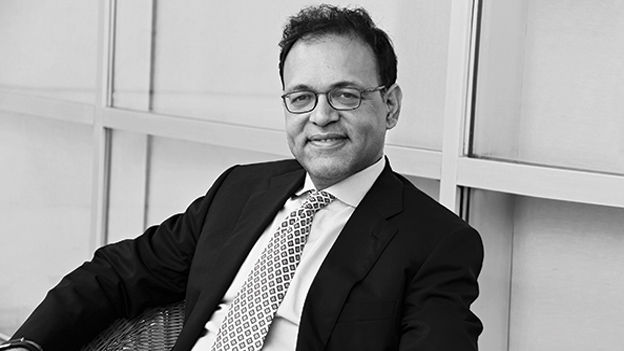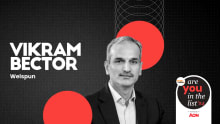Connecting with the hearts & the minds of people

There are inherent leadership qualities in everyone and people can develop them no matter what stage of life they are in
Q. What are the challenges CEOs in India face today and how have those evolved?
A. One of the ways I’d like to think about leading as a CEO is how you lead in business, how you lead change, and how you lead yourself. I think there are multiple challenges along all those dimensions. In leading business, a major challenge is dealing with the high degree of volatility and uncertainty in the market. In the past two years, while India has been insulated to some extent, it is pretty clear that we live in a very globally connected world and cannot be immune to what happens around us. The second challenge, I’d say, is that even if your business is local, you are dealing with MNCs and competing in a global environment. Earlier, cement used to be considered a local business, but today the biggest companies in the space are MNCs. So the challenge is to understand global expectations and learn to compete with the best. The third business challenge has everything to do with people. While Indian business aspirations remain high, there is a gap between aspirations and the ability to execute. And people make the difference. The reason I’m pointing that out is because it’s not easy to find talent in business areas that are unfamiliar in the country. How do you attract people and how do you equip them with the skills, knowledge and the mindset required in many of those businesses? Part of leading a business well is to find the right people with the right skills.
Change is a constant challenge. CEOs have to know what to preserve and what to change. Many companies have become successful by applying what they have learnt from the outside. Externally orienting is the first challenge. The second challenge is managing the balance between performance and health – on the one hand, you have to counter the relentless pressure from investors, analysts and shareholders to perform, and on the other, you have to safeguard long-term health by leading and adapting to change. The third challenge in managing change is dealing with conflicting expectations of different stakeholders. Today’s CEOs have to deal with Boards, investors, JV partners, regulators and not all of those expectations are aligned. That creates stress.
Finally, on leading self, in this complicated 24x7 globally interconnected world, it is a challenge for CEOs to find the right balance and lead their lives holistically. It is getting increasingly difficult to separate business from personal life. How do you define this integrated life? How do you have a sense of purpose and mission that gives energy to continue? How do you learn to be more self-aware about things that make you distinctive and how do you compensate for what you are not good at? Those would be my top challenges in leading business, leading change and leading self.
Q. In the work that you have done with McKinsey Leadership Institute and the Bower Forum, how has the training to become a CEO changed to address these challenges?
A. Firstly, it is still a journey. I wouldn’t say we have fundamentally changed it. Let me give you a glimpse of what we have accomplished so far. One of the insights we have from our leadership development work is that you learn through your own experience. People are not taught to do something if they never had the need to do it. One of the tenets in our training is to learn from each of those experiences. Secondly, CEOs are extremely lonely and don’t know who to reach out to, to have a confidential discussion with about things on their minds. We have a very intimate confidential forum where we make people engage with each other in an informal, comfortable setting. People open up to talk about issues that concern them. Thirdly, we talk about stuff that really matters, like what is the hold-back for the CEO to break through to the next performance frontier. We don’t restrict ourselves to the technical domain. It is very individual and depends on who you are, what business you run, etc. Finally, what makes it effective is that you have access to highly experienced global CEOs in the room who have the experience of having been there, done that. So, it is really a combination of these three things that make it kind of a unique experience that CEOs don’t get elsewhere.
Q. How do we get business leaders to managing much more complexity in their roles than what they are managing today? Is it possible to accelerate capacity building following these three tenets you’ve mentioned?
A. I don’t think just one intervention is enough. We are also thinking about what follow-on interventions would be required in the program, not just through the forums, but the work we do with companies on expanding leadership capacity. We are convinced there are inherent leadership qualities in everyone and people can develop them no matter what stage of life they are in. I think it is a function of certain critical things: You have to create the need and the desire to own the change. You have to help people identify the mindset and beliefs that they need to work on. Once that happens, it is important to create an enabling environment by providing support, feedback and encouragement. There should be some degree of handholding and structure to help people stay the course. When we have done this with clients, we have managed to make an incredible contribution to their progression along desired leadership trajectories.
Q. How do you make an intervention that doesn’t just impact the CEO level but becomes a way of life within the organisation?
A. The work we do as a leadership institute is not just focused on the individual CEO. What is unique about the intervention is that it brings CEOs from diverse industries and companies together. Shared experiences and insights help not just the CEOs but their organisations as well. A CEO alone cannot do very much. The work we do helps CEOs understand the needs of their companies and can impact hundreds, if not thousands of people in their organisations.
Q. What is required for organisations to undergo transformation successfully?
A. I think it is hard to imagine a transformation, which did not start somewhere. There is a core that starts it all. One person alone can’t achieve the transformation, but it is surprising to see how much of a difference a person can make. I’ve seen some legendary CEOs who alone have caused a disproportionate amount of outcomes not because they did it themselves, but because of who they are, and how they got others to do it. These CEOs tend to be humble and self-effacing people. The ability to rally a group of people together to pursue a certain mission is critical. At the end of the day, you have to connect with the hearts and minds of the people. How you make those connections influences how successful the eventual transformation will be.










